The beautiful name “pink splashes” has been given to a new variety of roses, the small buds of which cover the bushes from top to bottom. How to care for spray roses, and which variety of these bright flowers to choose for planting in the country?
Among all varieties of roses, one of the most beautiful and unpretentious garden plants are spray roses. This subspecies was bred from the Floribunda variety, and received its name because of the unusual appearance of the plants: roses on the bushes cover the shoots from top to bottom, the bush, according to the description, looks as if it was generously sprayed with red paint. That's why spray roses are often called rose splashes.
The best varieties of rose spray
The constantly increasing demand for spray has led to the fact that more and more varieties began to appear in the world selection every year. Next, we will familiarize ourselves with the description of the most common varieties.
Lydia
Considered the ancestor of many cultures. The variety was bred by Dutch breeders at the end of the last century. The plant is distinguished by a spreading bush up to 70 centimeters in height, flowers up to 4 centimeters in diameter with pink petals.
Rose Mimi Eden
It differs from the rest in its beautiful white inflorescences with a pink tint. At the stage of formation, the buds are apricot, when they bloom they become pink. The initial color of the petals changes to white under prolonged exposure to sunlight.

Tamango
The bush of the compact decorative rose Tamango reaches a height of 50 centimeters. The buds of this culture, up to 7 centimeters in diameter, consist of numerous dense scarlet petals. Each branch can simultaneously accommodate up to 12 peduncles. A feature of the variety is considered to be high levels of winter hardiness.
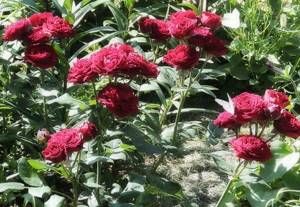
Tiramisu
Dutch rose Tiramisu is distinguished by two-color buds. The height of the plant bush does not exceed 50 centimeters. The flowers are small, 12-15 pieces per brush. The outer side of the petals is terracotta, the outer side is cream.

Orange
The orange variety lives up to its name, because it has bright orange petals. The buds resemble a tea rose in appearance, their diameter does not exceed 4 centimeters.

Rubicon
Rubicon spray roses have large, goblet-shaped purple buds. These flowers create a light, refined aroma.

Typhoon
Terry rose Typhoon has orange-red petals, which turn yellow closer to the middle.

All varieties of spray roses are often used to create wedding bouquets.
Description of orange roses
Orange color symbolizes happiness, joy, good mood. According to the description, red roses can be of different shades. Florists characterize these tones as follows:
- salmon orange;
- orange-scarlet;
- cinnabar and others.
This is interesting: Peony season
The color of the petals can be blurry and heterogeneous, which makes the flowers bright and delicate at the same time.
For beginners, floribunda roses and scrub forms are easiest to grow in the garden. Floribunda is characterized by continuous and abundant flowering. Orange buds are collected in clusters on their shoots and look very impressive. It is difficult to find a more decorative decoration for the garden.

Shrubs grow in the form of a large bush with large flowers. Srab roses look great in single and mixed plantings next to plants of other species. It is this variety that most often captivates with its delicate aroma.
Climbing roses with their long curly shoots create a real waterfall of flowers and look mesmerizing. They are divided into ramblers with a single but long flowering and climbers with powerful shoots and large flowers that bloom until frost. Climber roses are also good because they are less susceptible to disease than others due to the fact that they have good immunity.
Site selection and soil preparation
Both beginners and experienced gardeners can grow crops; the main thing is to follow all the nuances of cultivation. To plant a plant in the garden, you need to choose a sunny but protected from the winds area.
It is advisable to plant varieties with light petals in sunny areas, while roses with dark inflorescences are recommended to be placed in partial shade. If this is not done, then with high solar activity the intense color of plant buds will soon become light.
It can take up to three months to prepare high-quality soil for flowers, so for planting in the fall, the soil must be prepared in the summer or in October, if planting the crop is planned for spring.
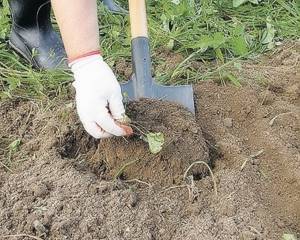
The basic rules for soil preparation are as follows:
- We remove weeds and their rhizomes from the site.
- We dig up the soil onto the bayonet of a shovel while simultaneously transferring the soil. Next, make a ditch 40-50 centimeters deep and fill the bottom with top soil with fertilizers, and then the bottom layer mixed with fertilizers. Over several months of standing, the soil in the ditch sags and becomes saturated with useful substances. Along with this, excess moisture also leaves.
- Some gardeners immediately plant plants in pre-dug soil with dug holes, but this method is considered less effective.
If plants are planted in pre-prepared, well-drained soil, the root system will quickly develop and receive unhindered access to oxygen.
Many gardeners do things differently. They dig up the area using a spade blade without prior leveling in the fall. This will help freeze the top layer of soil and destroy pathogenic bacteria and microorganisms harmful to roses and pest larvae. Fertilizers added during this period can dissolve over the winter.
With the arrival of spring, the planting site is leveled with a metal rake and holes for planting crops begin to be dug. The depth and width of such recesses should be 25-30 centimeters higher and wider than the root system of the plant. If these parameters are observed, the pit is filled with light nutritious soil, which will give impetus to the intensive development of the root system.

When preparing the soil for a rose garden, it is necessary to take into account the influence of its predecessors. It is known that roses do not grow well in areas where there were previously cinquefoil, cherry, quince or hawthorn. In such areas, a 50-centimeter layer of soil is removed and replaced with new soil.
The acid composition of the soil can be determined by litmus paper. So red color indicates acidic soil, blue indicates neutral acidic soil. Sorrel and horsetail usually grow on acidic soil, and clover or horseradish on alkaline soil. If there is alkaline soil, superphosphate or compost or pine needles are added to its composition. Add wood ash or bone meal to acidic soil.

The use of roses in landscape design
Flowers play a very important role in the design of personal plots. Hybrid tea varieties of roses, with their variety of sizes and colors, can serve a variety of functions.
So, tall bushes are good to plant near garden arches and wooden arbors.
Hybrid tea varieties of roses often decorate gazebos and garden arches
A rose bush can become the center of a composition in a flowerbed - in this case it is planted in the center, and a small hedge is made along the edges.
Group planting looks impressive when each color or variety of roses has its own area.
And some gardeners make real flowering hedges from hybrid tea roses, planting them to frame garden paths.
How to choose the right seedlings
Rose planting material can be sold in mini containers or in bags filled with nutrient substrate, less often in open form. When planting in the fall, it is better to choose seedlings with an open root system, but for planting in the spring, plants in containers are better suited.
Before purchasing, carefully inspect the bush and its root system for damage and other defects, such as mold and dried areas. If you purchase plants in a bag, pay special attention to the condition of the soil; it should be crumbly and not have a specific smell. The best choice would be a strong, healthy seedling with white roots at the bottom.
A successful combination of the scion and the rootstock is indicated by smooth callus at the grafting site.
Pros and cons of use in landscape design
Advantages of working with bush roses:
- varieties with early and late flowering periods transform and fill the garden with different aromas throughout the year;
- by alternating compact and wide, low and tall bushes, you can design your rose garden in an original way;
- flowers of the same variety with an unusual shade of buds, planted in ridges of geometric shapes, serve as a single decoration.
Shrub roses are combined with deciduous and coniferous shrubs, creeping plants, and ferns.
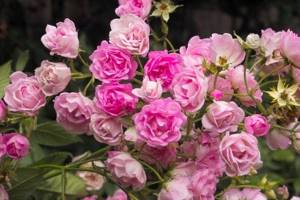
A classic of the landscape genre - English rose bushes in the form of a hedge. For lovers of traditional garden design, these are the first choice plants. Their disadvantage is that the bushes cannot be given an irregular shape or used in patterns and fantasy compositions. The corners and curls will be hidden under the green leaves.
Preparing seedlings for planting
Before planting, the stems of rose seedlings need to be trimmed. At the same time, buds, damaged and shriveled branches are removed. 4...5 eyes are left on the main shoots of the bush. less developed stems should contain at least 3 buds. It is also necessary to lightly trim the lateral roots and remove damaged ones.
For disinfection and speedy healing, carefully coat all cut areas with garden varnish.
After carrying out these operations, plants with bare roots are placed for 12 hours in a solution of water and sodium humate. To prevent drying, the roots of the seedlings are dipped into a mash made of clay, water and a root formation stimulator, the components are mixed until a creamy consistency. After this, the root system is carefully wrapped in moistened burlap.
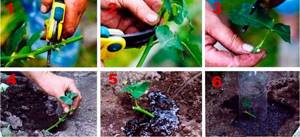
Wonderful aroma of roses
One of the goals that David Austin set for himself was to return roses to their inimitable aroma.
And there is no point in denying it: he did it brilliantly. Among the beauties of Austin, there are simply no such roses that would not emit any scent at all. However, it should be taken into account that the degree of saturation and character of the aroma of each rose variety is unique.
There is a large series of “rose” varieties that exude the fragrance of a forgotten classic, like antique roses from ancient times.
The most fragrant among them are Gertrude Jackie, which can often be found in city parks.
Landing
Planting spray roses can be done by both an experienced gardener and an amateur. The entire work process can be divided into several stages:
- we dig a planting hole with a depth and width of 45-50 centimeters;
- We fill the bottom of the ditch with drainage in the form of small pebbles and coarse sand;
- scatter organic matter (compost and humus);
- sprinkle nutrients with a thin layer of soil;
- carefully straighten the roots, place the seedling in the hole and sprinkle it with soil.
After carrying out such actions, we water the rose with warm water. For each bush you need to use 6-8 liters of liquid.
Nuances of care
From March to July, apply fertilizing with a high content of nitrogenous substances. In summer and until autumn, add potassium and phosphorus. It is important to feed during budding and at the end of pollen. Loosen the soil around the bush regularly. For the winter, cover the plant. In hot weather, it is worth spraying the petals with water, but in the late afternoon, when the sun sets.
Watering
Water miniature roses with Spray in the same way as other varieties of Rosaceae. Pour water under the root so that it does not fall on the leaves. Start irrigation when the soil dries out after the previous watering. One bush will need 8 liters of water.
Do not use ice-cold liquid; it must be at room temperature. Afterwards, weed the ground so that there are no crusts.
Top dressing
It is advisable to fertilize roses periodically. Feeding is especially required during budding and pollen. The procedure is carried out according to general rules:

- during the appearance of buds;
- at the end of summer.
Roses love nitrogen fertilizers. By autumn, add potassium-phosphorus compounds. You can buy ready-made mixtures in the store and dilute them according to the instructions.
Wintering
Before frosts, around the beginning of October, cut rose bushes to a height of 30-40 cm. Remove leaves, buds, and flowers from them and cover them with soil up to 30 cm up. Pine needles are placed on top and covered with burlap. If the roses are covered with snow, do not worry. This will serve as additional shelter and add moisture to them.
How and when to prune
Shrubs need to be pruned in order to activate the formation of young shoots and long flowering. Perform pruning 2-3 times during the growing season. At the same time, remove damaged and dry branches. When flowering is complete, remove faded flowers. Shorten the bush in June so that the rose does not waste energy on producing fruits and the pollen is more intense. Pruning will serve as an excellent prevention of fungal infections.

Sources used:
- https://stroy-podskazka.ru/rozy/sorta/sprej/
- https://7ogorod.ru/cvety/oranzevye-rozy.html
- https://qlumba.com/sad/719-roza-sprej
- https://dachamechty.ru/tsvety/roza/sprej.html
Growing
Further care for roses is simple. All that is required is to loosen the row spacing and remove weeds in time, as well as water and fertilize, and trim shoots on lush bushes. Next, we will look at all the events in more detail.
Watering and fertilizing
Plants need regular, abundant watering throughout the growing season, and especially during flowering during persistent drought. Laying mulch in the root zone of the plant will help simplify the process. A thick layer of sawdust or low-lying peat will prevent moisture evaporation.
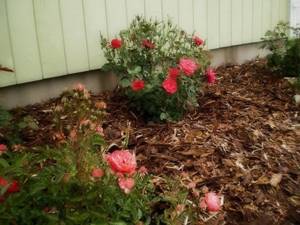
In the absence of a mulch layer, the soil must be constantly loosened and weeds removed. In hot weather, burns may appear on rose leaves. To prevent this phenomenon, the bushes are watered with warm water in the evening using the sprinkling method.
For long-term intensive flowering, spray roses must receive additional nutrients, which are applied to the soil in the form of fertilizing.
At the initial stage of development, before the first buds appear, nitrogen is needed. Flowering shrubs take a significant amount of phosphorus and potassium fertilizers, as well as microelements, from the soil.
Correctly trim and form the bush
Not only old, but also young bushes are subject to formation. After pruning in the fall, strong woody branches with buds should remain on the plant. Old, shriveled or wind-damaged shoots are not left on plants. When pruning roses, the following rules must be observed:
- use pre-disinfected sharp pruners or other tools for work;
- pruning is carried out from below to the top of the bush;
- cuts are made above the outer bud at an angle of 45 degrees;
- If there is a possibility of the plant being damaged by diseases and pests, the wounds are covered with garden varnish.
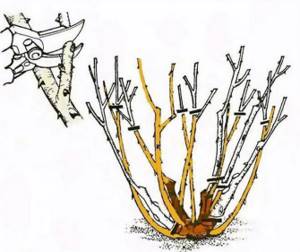
The technology for forming a bush depends on the crop variety. So short pruning is used for heavily bushing plants. With average formation, the bush is shortened by half its length, leaving 30 centimeter stems with 5...6 buds. Long pruning involves removing 2/3 of the branch and helps achieve early flowering.
Similar work is carried out in the fall in the evening when the weather is warm. During shaping, the 5 most developed shoots are determined on the bush, the rest are removed at the root.
A healthy shoot does not have a large number of lateral branches, has dark green bark, and has a diameter of at least 1 centimeter.
On the selected stems, five buds are counted from below and an even cut of the wood is made. During work, make sure that the top bud remains on the outside. A distance of 1 centimeter is removed from it and an oblique cut is made towards the middle of the bush. After trimming the wound, the plants are covered with garden varnish and the branches are removed.
Preparing for winter
For normal wintering, it is necessary to make a hill of soil above the plant shoots. Before hilling, remove non-lignified shoots, flowers and leaves. Experienced gardeners already cut off all the flowers and buds of roses in the last ten days of October. This will help harden the plants and prevent the use of additional nutrients from the soil. Sand or dry soil is poured over the stems of roses to a height of up to 35 centimeters. Next, the hill is covered with sawdust, lowland peat or spruce branches.
Do not take soil from between the rows of flowers; such actions can cause damage to the root system of the plants.
There is another method of covering roses for the winter, air-dry. It consists of constructing an improvised frame made of metal wire up to 50 centimeters high. Next, this structure is furnished with foam rubber, foam sheets or reeds. Next, a plastic film is stretched over the frame, which will protect the plant from moisture penetration. To prevent the destruction of the material, the hanging pieces of film are sprinkled with earth. An improvised shelter can be ventilated before the onset of cold weather with negative temperatures below -15 degrees.
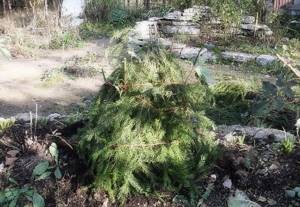
Basic information
So spray rose is a new group of roses. It appeared thanks to the efforts of flower growers and botanists in the second half of the twentieth century and over the past time has managed to fall in love with flower growers around the world. This type of flower is also called patio rose.
The spray group appeared as a result of separation from the floribunda group of roses. The new species is represented by compact low bushes. Their average height is approximately 50 cm, although sometimes they can grow up to 90 cm. About 15 buds can bloom on one branch.
The flowers themselves can be large, medium, or small, creating the impression of “splashes” on the bush. The diameter of spray rose flowers is from 4 to 7 cm. There are a large number of flowers on one bush, which is why this plant is called “pink spray” (English: “pink spray”). These are decorative and very elegant plants, they are used to decorate personal plots, and are also used to form bouquets, in particular wedding ones, which is why these flowers are often called “wedding”.
Spray roses combine the best qualities of flowers:
- abundant and long flowering;
- unpretentiousness to conditions of detention;
- endurance in Russian climatic conditions.
They can be grown in Russia due to their excellent resistance to frost. There are not many thorns on its stems, and sometimes they are completely absent. If this plant is pruned correctly, you can get continuous or simply very long flowering: with the arrival of warmth and before the onset of the first cold weather.
The plant is actively used in landscape design. It is grown in containers, rose gardens, and also on the street along paths. The flowers have a light, pleasant aroma.
How can I propagate
In practice, several methods of propagating spray roses are used:
- Using seed material. A labor-intensive method that involves collecting and stratifying grains and growing seedlings.
- Rooting of roses by layering is carried out in the spring. With this method of propagation, one of the lashes is bent from the mother bush and covered with earth. By autumn, this shoot will have its own roots, after which it can be transplanted to a new place as a separate plant.
- Using root suckers. Such plants are separated from the mother bush a year after emergence, when they have their own root system.
- By cutting method. In the middle part of the shoot, several pieces of the stem are cut and placed in a solution of water and a growth stimulant. Subsequently, the plant is rooted in a special greenhouse or schoolhouse under a certain temperature and humidity regime.
- In the case of dividing a bush, the rose is cut into pieces. In this case, each plot must have its own root system and 2…3 developed buds.
The fastest method of propagation is considered to be dividing the bush. In this case, spray roses retain varietal characteristics. The use of seed material is practiced by breeders to obtain new types of crops.
Trimming
Pruning is very important for spray roses. It stimulates the formation of young branches and ensures more abundant and prolonged flowering. It is recommended to prune several times during the season. At the same time, dry and damaged branches are removed. Also, at the end of flowering, it is necessary to trim off faded flowers.
It is especially important to prune the bush in the summer so that the plant does not waste energy on producing fruits, but blooms more intensely and abundantly. In addition, pruning is a fungus prevention.
Pest and disease control
Aphid
The main pest of spray roses is aphids. These small insects settle in colonies on the inside of the leaves of the crop. Parasites suck sap from plants, which leads to wilting and curling of leaf blades. Aphids reproduce intensively, producing up to 10 generations per year.
The presence of aphids on plants can be unmistakably determined by damaged leaves or chaotically moving ants (they feed on the sap of the parasites).
To effectively combat the pest, use a soap solution with the addition of mustard powder or chemicals Karbofos, Aktelik, Rogor.
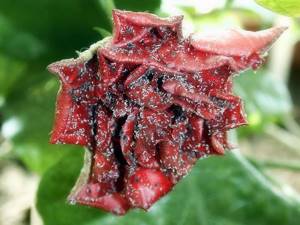
Leafhopper
Another dangerous pest of the rose garden is the leafhopper. After parasitism by this insect, the leaves of the flower become covered with white spots and lose their original appearance. With severe damage, yellow spots appear on the surface. To combat the parasite, chemicals and insecticides are used.
A pale yellow or white leafhopper with an elongated body does not pose a threat to the plant. The main damage is caused by insect larvae that feed on plant juices.
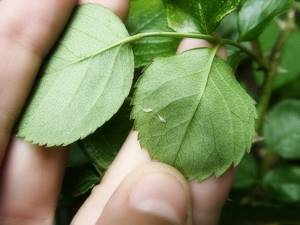
Spider mite
Spider mites cause particular harm to crops. Its oval-shaped body up to 0.5 millimeters long consists of 4 pairs of legs. The color of the body is red or orange, the larvae are greenish. Parasites damage the lower surface of rose leaves and suck out the juices, which leads to the appearance of yellow spots and loss of decorativeness of the plant.
The pest can be detected using a magnifying glass or by the thin webs connecting the leaves.
Mite settlements can be destroyed with chemicals such as Vermitek or Fitoverm.
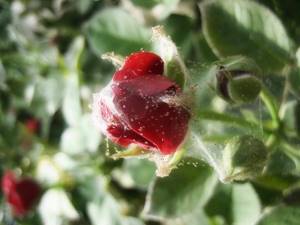
leaf roller
Of the rose pests, you should pay special attention to the leaf roller. Caterpillars appear on the plant in early spring, begin to chew buds and young shoots, then take hold of the leaves. The caterpillars are collected by hand and destroyed; in case of severe lesions, the plant is treated with insecticides.

Powdery mildew
Of the rose diseases, powdery mildew is considered the most popular. The disease manifests itself in the form of a powdery white coating on the leaves and shoots of the crop.
The reason for its occurrence may be moderate temperature and high humidity.
Prevention of powdery mildew is spraying plants with Bordeaux mixture and applying phosphorus-potassium fertilizers. At an intensive rate of disease development, roses are sprayed with a 0.5% concentration of soda ash solution.
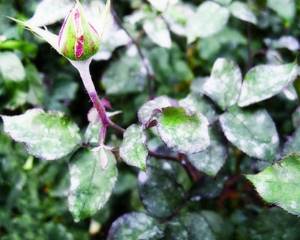
Black spot
This is a fungal disease that appears on the leaf blades of roses in the form of brown spots from mid-summer. Severe damage leads to complete blackening, drying out and falling off of the leaves. Fungal spores overwinter in fallen leaves and shoots, which is why organic remains must be removed from the site and burned.
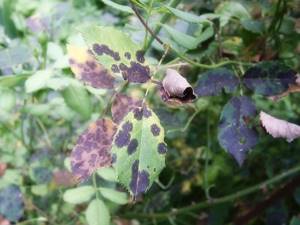
Another effective solution to the problem is the spring treatment of rose leaves with Bordeaux mixture.
Even a novice gardener can handle growing spray roses. The main thing in this matter is to follow the rules of planting and caring for plants, to carry out timely treatment of flowers from diseases and pests.
Reviews and opinions of gardeners
In Russia, the most popular varieties are Lydia, Ruby Star, Mimi Eden, Fire Flash . Reviews about them are left on forums more actively than about others. Moreover, these opinions are mostly positive - these varieties deserve them.
The most frequently discussed issue is wintering. In central Russia, it is advisable to cover the crop for the winter, despite the fairly high winter hardiness of all varietal species. It is recommended to cover with spruce branches or pine needles.
In general, no additional measures to care for the plant are required. The exception is pruning. It stimulates flowering, which lasts throughout the season. When pruning after flowering, leave about 15 cm from the soil surface.
It is advisable to purchase grafted bushes from trusted stores and nurseries, and plant them in the fall, around mid-September.
Gardeners' opinions about the Tamango rose
This beautiful spray rose is the star of my garden. I grow it in small flower beds. I have never had any difficulties growing it in 5 years. They say that the variety is resistant to diseases, except for black spot, but this has passed me by, I regularly do various treatments and so far my roses have not gotten sick.
Ksenia Sochi
I've had this variety for several years now. It stands out from other plants. I really like the variety, although the roses are resistant to various diseases, which is very good
But even if this variety had its drawbacks, because of its beauty and sweet aroma, I would turn a blind eye to them!
Irina Voronezh
The variety is popular due to its continuous and lush flowering and its compactness (it was important for me that the bush was small, because there is already little space on my site). I’m new to this business and have never grown anything before; with the advent of the dacha, I learned about seedlings, loosening the soil, etc.
But with this variety everything was easy and I didn’t have any problems. The roses of this variety are very beautiful with a pleasant delicate aroma and completely problem-free. For me, they survived a season of prolonged and heavy rains, but they did not suffer at all.
Arina Volgograd
You can see what a rose looks like in the following video:
This beautiful variety will decorate any area, and reviews from gardeners who grow it prove that this variety has a huge number of advantages and virtually no disadvantages.
How to plant roses and care for them
Planting and caring for roses is simple. First you need to choose a place for them.
Light roses can be planted in a sunny place. It is better to root dark flowers in a semi-shaded area, as they will fade in bright light.
Disembarkation process:
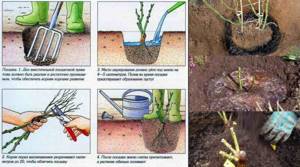
Stages of planting bushes
- First, holes are dug with a diameter and depth of 0.5 m.
- Drainage made of fine gravel is laid at their bottom, in a layer of 15 cm.
- Then a bucket of organic fertilizer (humus, peat with ash, compost) is placed in the hole.
- The fertilizer is covered with soil.
- Then the seedling is lowered into the hole. Its root is straightened and covered with soil.
- Lastly, the bushes are watered at the rate of 8-10 liters of water per seedling.
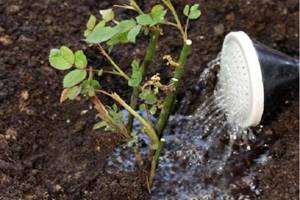
The planted rose is watered abundantly. Photo: dachamechty.ru
In order for flowers to develop faster and bloom luxuriantly, they are fertilized:
- in the spring, before the start of the growing season, these should be nitrogenous preparations (urea, ammonium nitrate);
- During the formation of buds and flowering, roses are fed with a phosphorus-potassium complex.

Photo: terragro.profilend.net Roses need to be watered periodically. This is done twice a week. Each bush should have up to 10 liters of water.
The root zone of the bushes is cleared of weeds every two weeks and then loosened. This improves air exchange and simplifies moisture access to plant roots.
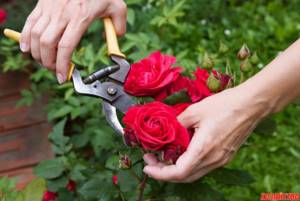
Every season it is necessary to carry out sanitary pruning of bushes. Photo: hozvo.ru
Pruning improves and prolongs the growing season, and also rejuvenates bush roses:
- in April, dried, diseased, damaged and weak branches are cut off from plants;
- during the summer, faded buds are removed;
- In October, roses are molded, and excess shoots are cut off.
Types of Rose Flowers
Types of roses include variations in bud formation, plant height and suitability for cutting. The following describes flowers such as roses, which are most often grown in individual gardens.
Single color. The petals are uniformly colored over the entire surface, although some color change may occur during flowering. Example: Iceberg.
Two-color roses. The color of the outer surface of the petal is noticeably different from the inner one. Example: Piccadilly.
Multicolor roses. The color of the petals changes noticeably as they fade. The inflorescence simultaneously contains several flowers of different ages with different colors. Example: Masquerade.
Mixed roses. Two or more different colors blend seamlessly within each petal. Example: Peace.
Striped roses. Two or more different colors on each petal, one of which forms separate stripes Example: Rosa Mundi.
Painted. Silvery petals with red spots and streaks on the surface and a white eye at the base Example: Regensberg.
Falling roses. The flower, which initially has a good shape, opens wide when blooming, showing the stamens.
Ball roses. The petals are collected into a regular ball with a closed center.
Cupped roses. Numerous petals are collected in a bowl shape.
Quadruple roses. The inner petals are folded into four separate sections instead of forming a single cone.
Flat roses. The classic shape of hybrid tea roses—long inner petals form a cone in the center of the flower.
Rosette roses. A flat flower with a low center and numerous, regularly spaced short petals.
Pompom roses. A round flower with numerous, regularly arranged short petals.
Advantages and disadvantages
Advantages:
- frost resistance;
- persistent delicate aroma;
- rich color;
- the flowers can withstand the sun;
- the variety does not require special care;
- lush and continuous flowering;
- small bush size;
- pleasant aroma;
- the petals will not deteriorate after rain;
- small and lush buds;
- disease resistance;
- The variety is resistant to pests.
Flaws:
The variety is poorly resistant to powdery mildew.











